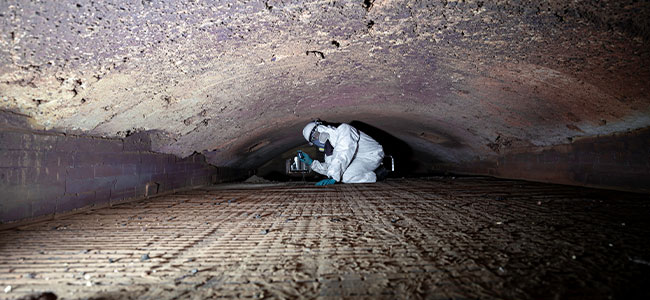
Page 2 of 2
Training Is Essential to Prevent Fatalities in Confined Spaces
It is highly recommended that continuous ventilation be employed since the atmosphere may change without notice due to the type of work taking place. This work could include something as simple as welding or employing a chemical for cleaning.
Consider Checklist Before Entering
If a permit needs to be issued, it must contain specific information before entry can be made. It must have:
• The space to be entered. The purpose of the entry.
• The date and the authorized duration of the permit. OSHA does not indicate exact times that a permit is approved.
• The authorized entrants.
• Personnel listed serving as attendants.
• Entry supervisor.
• Any hazards in the space.
• Measures used to isolate the space and abate or eliminate the hazards.
• Acceptable entry conditions.
• Results of initial tests and any follow-on testing that should be accomplished every 15 minutes.
• Rescue services.
• Communication procedures.
• Equipment (PPE, meters, fans, communications, rescue) which is being utilized.
• Any other permits including hot work (electrical or gas welding), lockout/tagout to authorize work in the space.
Employees authorized to perform permit-required confined space entry must be trained before they are assigned entry duties.
Levels of Training for Company Workers
Employees who are responsible for the overall operation (supervisor) must be trained to:
• Determine if space can be entered safely.
• Ensure logs are maintained as required to monitor oxygen levels and any hazardous atmospheres that could find their way into the space.
• Terminate the entry and cancel the permit once all personnel have been removed and the space has been closed.
Employees who work in confined spaces (entrants) must be trained to:
• Alert attendants about hazards.
• Understand warning signs.
• Use suitable personal protective equipment (PPE).
Employees who assist entrants from outside the confined space (attendants) must be trained to:
• Determine hazards.
• Monitor work conditions.
• Coordinate resources.
• Maintain worker count.
• Communicate with entrants.
• Allow only qualified and authorized entrants to enter the space.
Should an incident occur, it is incumbent upon the contractor(s) making the entry to have rescue and emergency services available. This rescue could include the use of a tripod and winch which would be operated by the attendant or other personnel, or a rescue team or service.
The bottom line is that any time a limit is exceeded, no matter what the reason, all personnel shall immediately exit the space, and no others shall enter until atmospheric conditions are returned to safe levels.
Remember that OSHA standards address confined spaces in specific regulations for general industry, maritime, and construction. Safety training is crucial to prevent accidents and protect the lives of workers in confined spaces.
This article originally appeared in the April/May 2024 issue of Occupational Health & Safety.
About the Author
Columbia Southern University Adjunct Professor Ralph Blessing has more than 27 years of occupational safety and health experience encompassing general industry, construction, training, and public speaking. He became certified as an afloat safety manager and received his Safety Management Certificate from the Naval Safety Center during his tour of duty in the U.S. Navy. Blessing holds a master's degree in occupational safety and health.